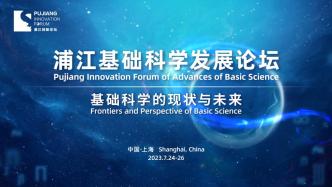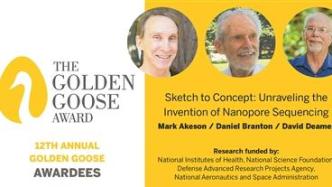
On September 27, the American Association for the Advancement of Science, the world's largest multidisciplinary science society, and the Association of American Universities, a founding member of the Golden Goose Award, co-hosted the 12th Golden Goose Award Ceremony.
The Golden Goose Award is awarded to research funded by the U.S. federal government that may seem obscure or comical at first, but ultimately has a profound social impact.
This time, the award selected five researchers in the fields of biology, agriculture and genomics to commend them for their unexpected breakthroughs.
Nanopore sequencing sprouts on the road
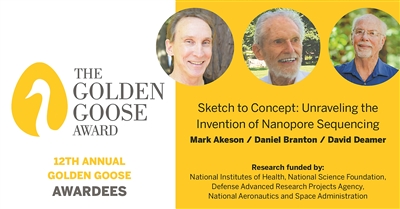
In 2014, nanopore sequencing was commercialized as a $1,000 pocket-sized device and is widely used for monitoring and pathogen analysis of infectious disease outbreaks such as tuberculosis, Ebola virus, Zika virus, and new coronavirus.
Winners: Mark Akeson (UC Santa Cruz), Daniel Branton (Harvard University), and David Deamer (UC Santa Cruz)
It was a DNA sequencing method accidentally conceived by a scientist that later inspired the technology industry to create cost-effective, pocket-sized devices that can perform analysis in any environment and help people save more lives.
The original idea for nanopore sequencing came to David Deemer in 1989 while driving on a forest road in Oregon. He immediately pulled over to the side of the road and scribbled the concept down, but it soon became a note on his dusty desk. After a long time, Deemer and Daniel Blyton re-"excavated" these notes, and later collaborated with Mark Ankerson to successfully enable single-stranded DNA to read genetic sequences through the channel. This is now the nanopore. Sequencing technology.
They have been on the road to success for 30 years, and have encountered rejections from top journals and skepticism from the scientific community. But in 2014, nanopore sequencing was commercialized as a $1,000 pocket device and is widely used for monitoring and pathogen analysis of infectious disease outbreaks such as tuberculosis, Ebola virus, Zika virus and new coronavirus.
It has been used almost everywhere, including on top of Arctic icebergs, in remote areas of Africa where electricity is unreliable, and even on space stations in the universe.
Genetic data analyzed on the kitchen table
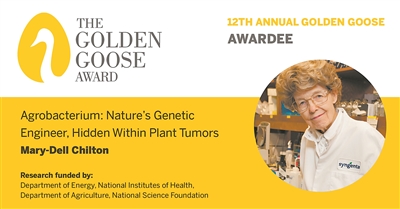
Marie-Dale Chilton discovered that bacteria could indeed transfer their DNA into plants, and she developed a technique called Agrobacterium-mediated transformation (AMT).
Winner: Mary-Dell Chilton (Syngenta)
In the 1970s, scientists sought to uncover whether bacteria's ability to repair their own DNA would curb plant growth, a survival strategy that threatened crops. To find out, Mary-Dale Chilton analyzed data at her kitchen table one day after her children had gone to bed. To her surprise, she found that bacteria could indeed transfer their DNA into plants. She eventually developed a technology based on this natural ability of the bacteria, Agrobacterium-mediated transformation (AMT), which is widely used by U.S. corn, soybean and cotton growers.
Cotton with insect-resistant properties could lead to a significant reduction in pesticide use (by 66% between 1994 and 2019), reducing costs and environmental impact while increasing crop yields and profits. Today, AMT is still used to deliver CRISPR/Cas9 components into plants, and it remains widely used in biotechnology research.
The scientific method of raising chickens started in childhood
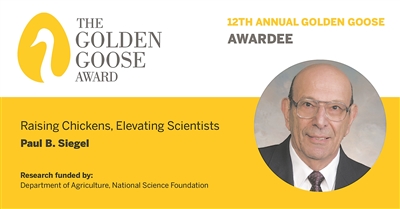
For 65 years, Siegel has been breeding two types of purebred chickens, high-weight and low-weight, with related lineages and another set of long-term immune-related lineages that continue to this day.
Winner: Paul Siegel (Virginia Tech)
Imagine a scientist running a set of experiments for 65 years and counting. This is Paul Siegel, who has been raising chickens on the farm since he was 3 years old. At an early age, he developed a curiosity about how best to breed and raise chickens. In 1957, Siegel began conducting his groundbreaking research in the laboratory. Today, at the age of 90, he still appears in the Virginia Tech laboratory almost every day.
For 65 years, Siegel has been breeding two types of purebred chickens, one for high body weight and one for low body weight. Their related lineages and another set of long-term immune-related lineages continue to this day, resulting in research on immune function, reproductive biology , discoveries of genome evolution, etc.
Siegel trained and mentored hundreds of students during his distinguished career. His work is well known to poultry scientists around the world and laid the foundation for modern methods of raising chickens, safeguarding this globally important food source.
Sudeep Parikh, CEO of the American Association for the Advancement of Science, said the Golden Goose Award "underlines the importance of investing in basic research across disciplines to drive innovation and improve lives" and allows "thousands of patents to be tracked."
What is the basic science that ultimately improves people’s quality of life? This award may raise awareness of the importance of this concept.
(Original title: "An unexpected breakthrough in a flash of creativity—the 12th American Association for the Advancement of Science Golden Goose Award is announced")
